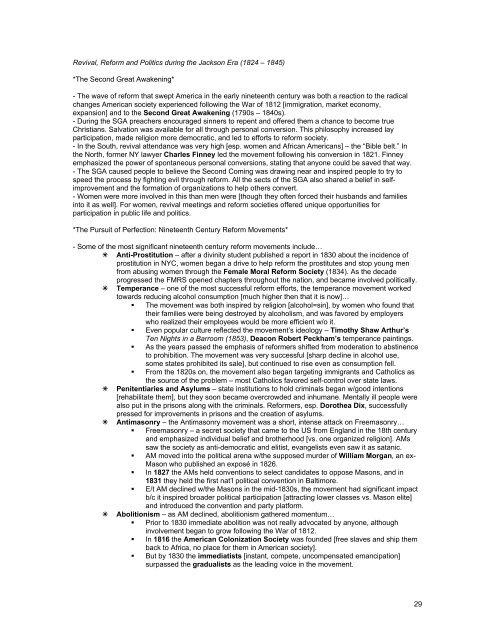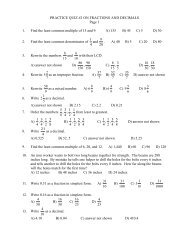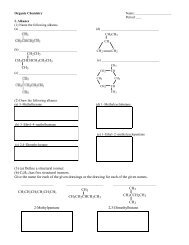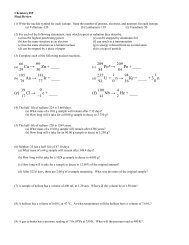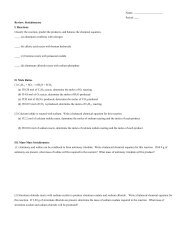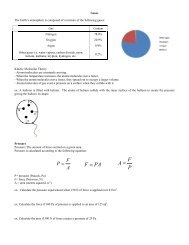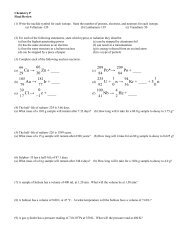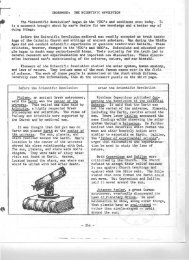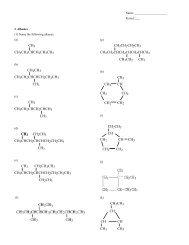- The Second Bank of the US, which was esp. attacked during the Panic of 1819, was finally killed off in1836, leading to a nat’l credit shortage, which, <strong>com</strong>bined with the Panic of 1837, led to reforms in banking.- The new free banking system, initially introduced in Michigan and NY, meant that any bank that metminimum standards would get a charter automatically. This stimulated the economy in the 1840s/1850s.*Workers and the Workplace*- At first, the young farm women who came to the NE textile mills were very optimistic, and the millsoperated on the paternalistic Lowell System, which provided the women with good working conditions.- But from 1837 – 1842, demand for cloth declined and the mills worked only part-time, causing managers topressure workers by speeding out the machines, giving each girl more machines to work, and paying extra ifworkers produced the most cloth. Hours lengthened, wages were cut, and discipline increased.- Workers responded by organizing and striking, but they were unsuccessful. In the 1840s, more concertedefforts to shorten the workday began – worker-run newspapers, labor organizations [these didn’t work thatwell b/c workers stayed only a short time]. Then, Irish immigrants replaced NE girls as the work became lessskilled in the 1850s.- Another important result of manufacturing was the sharp division between men’s and women’s jobs andcultures. Also, the market economy devalued the unpaid labor of women in the home.- The hierarchical organization of the factories, impersonal nature of labor, dangers from machines, and thelack of opportunities for advancement <strong>com</strong>bined to produce new labor organizations and labor parties.- Although the parties tended to agree on advocating free public education, an end to debt imprisonment,and were anti-bank/anti-monopoly, they were still divided, weak, and stayed pretty local. Their biggestac<strong>com</strong>plishment was to be<strong>com</strong>e legal though Commonwealth v. Hunt (1842).*<strong>Am</strong>erican Expansion and Indian Removal*- As <strong>Am</strong>ericans increasingly pushed West, the former occupants inevitably were forced onwards as well.Although the Constitution acknowledged Indian sovereignty and gov’t relations w/Indian leaders followedinternat’l protocol, in reality, it was a bunch of crap.- Basically, the US used treaty making to acquire Indian land – through either military or economic pressurethe Indians were forced to sign new treaties giving up more and more land. Some Indian resistancecontinued after the War of 1812, but it only delayed, not prevented, the US.- Many Indian nations attempt to integrate themselves in the market economy. For example, some lowerMississippi tribes became cotton suppliers and traders. This turned out badly, though, b/c the trading postswould extend debt to chiefs that would later be used to force them off the land.- As the cotton economy spread, then, Indians fell into patterns of dependency w/the <strong>Am</strong>ericans, whichmade it easier to move them. Indian populations also fell drastically due to war and disease.- The US gov’t also attempt to assimilate the Indians into <strong>Am</strong>erican culture [in 1819 $ was appropriated forthat cause and mission schools were est.] Missions taught the value of private property and Christianity. Formost, however, assimilation seemed too slow, and illegal settlers began crowding Indians everywhere.- By the 1820s it was obvious the Indians just weren’t about to give up land fast enough, and attentionturned to the more powerful, well-organized southeastern tribes.- In 1824, prompted by pressure from Georgia, Monroe suggested that all Indians be moved beyond theMississippi River [no force would be necessary, he thought]. This was aimed primarily at the southernCreeks, Choctaws, Chickasaws and Cherokees, who all rejected the proposal.- In the end, all the tribes were moved, making it clear that even adapting to <strong>Am</strong>erican ways could notprevent removal. The Cherokees were the best example – they had a constitution and political structure, butthe South refused to respect them. They appealed to the SC in Cherokee Nation v. Georgia (1831) and thecourt ruled in their favor. Still, Georgia refused to <strong>com</strong>ply.- Jackson decided not to interfere b/c it was a state matter [really b/c he just wanted to kick out the Indiansanyway] and allowed the Indians to be forced out w/funds from the Removal Act of 1830. The Choctawswere moved first, then the Creeks.- Finally the Cherokees [who were divided – some wanted to give up and exchange their land for westernland, most didn’t want to give up] were marched by military escort in the Trail of Tears in 1838 after theirlobby to the Senate failed.- Removal was a disaster for the Indians [you think?] – many became dependent on the gov’t for survival,internal conflicts arose, as did problems with existing tribes.- In Florida a small band of Seminoles continued their resistance through a small minority under Osceolathat opposed the 1832 Treaty of Payne’s Landing, which provided for their relocation. When troops weresent in 1835, Osceola used guerilla warfare against them until his capture and death in prison, after whichthe group fought under other leaders until the US gave up in 1842.28
Revival, Reform and Politics during the Jackson Era (1824 – 1845)*The Second Great Awakening*- The wave of reform that swept <strong>Am</strong>erica in the early nineteenth century was both a reaction to the radicalchanges <strong>Am</strong>erican society experienced following the War of 1812 [immigration, market economy,expansion] and to the Second Great Awakening (1790s – 1840s).- During the SGA preachers encouraged sinners to repent and offered them a chance to be<strong>com</strong>e trueChristians. Salvation was available for all through personal conversion. This philosophy increased layparticipation, made religion more democratic, and led to efforts to reform society.- In the South, revival attendance was very high [esp. women and African <strong>Am</strong>ericans] – the “Bible belt.” Inthe North, former NY lawyer Charles Finney led the movement following his conversion in 1821. Finneyemphasized the power of spontaneous personal conversions, stating that anyone could be saved that way.- The SGA caused people to believe the Second Coming was drawing near and inspired people to try tospeed the process by fighting evil through reform. All the sects of the SGA also shared a belief in selfimprovementand the formation of organizations to help others convert.- Women were more involved in this than men were [though they often forced their husbands and familiesinto it as well]. For women, revival meetings and reform societies offered unique opportunities forparticipation in public life and politics.*The Pursuit of Perfection: Nineteenth Century Reform Movements*- Some of the most significant nineteenth century reform movements include… Anti-Prostitution – after a divinity student published a report in 1830 about the incidence ofprostitution in NYC, women began a drive to help reform the prostitutes and stop young menfrom abusing women through the Female Moral Reform Society (1834). As the decadeprogressed the FMRS opened chapters throughout the nation, and became involved politically. Temperance – one of the most successful reform efforts, the temperance movement workedtowards reducing alcohol consumption [much higher then that it is now]… The movement was both inspired by religion [alcohol=sin], by women who found thattheir families were being destroyed by alcoholism, and was favored by employerswho realized their employees would be more efficient w/o it. Even popular culture reflected the movement’s ideology – Timothy Shaw Arthur’sTen Nights in a Barroom (1853), Deacon Robert Peckham’s temperance paintings. As the years passed the emphasis of reformers shifted from moderation to abstinenceto prohibition. The movement was very successful [sharp decline in alcohol use,some states prohibited its sale], but continued to rise even as consumption fell. From the 1820s on, the movement also began targeting immigrants and Catholics asthe source of the problem – most Catholics favored self-control over state laws. Penitentiaries and Asylums – state institutions to hold criminals began w/good intentions[rehabilitate them], but they soon became overcrowded and inhumane. Mentally ill people werealso put in the prisons along with the criminals. Reformers, esp. Dorothea Dix, successfullypressed for improvements in prisons and the creation of asylums. Antimasonry – the Antimasonry movement was a short, intense attack on Freemasonry… Freemasonry – a secret society that came to the US from England in the 18th centuryand emphasized individual belief and brotherhood [vs. one organized religion]. AMssaw the society as anti-democratic and elitist, evangelists even saw it as satanic. AM moved into the political arena w/the supposed murder of William Morgan, an ex-Mason who published an exposé in 1826. In 1827 the AMs held conventions to select candidates to oppose Masons, and in1831 they held the first nat’l political convention in Baltimore. E/t AM declined w/the Masons in the mid-1830s, the movement had significant impactb/c it inspired broader political participation [attracting lower classes vs. Mason elite]and introduced the convention and party platform. Abolitionism – as AM declined, abolitionism gathered momentum… Prior to 1830 immediate abolition was not really advocated by anyone, althoughinvolvement began to grow following the War of 1812. In 1816 the <strong>Am</strong>erican Colonization Society was founded [free slaves and ship themback to Africa, no place for them in <strong>Am</strong>erican society]. But by 1830 the immediatists [instant, <strong>com</strong>pete, un<strong>com</strong>pensated emancipation]surpassed the gradualists as the leading voice in the movement.29
- Page 3 and 4: Congregationalists (Puritans) - The
- Page 5 and 6: - So the Restoration Colonies, form
- Page 7 and 8: - So in England, where they were lo
- Page 9 and 10: *Colonial Politics 1700-1750: Relat
- Page 11 and 12: - Another ideology that was beginni
- Page 13 and 14: - The Quebec Acts were passed aroun
- Page 15 and 16: - So, by 1782, what had seemed to b
- Page 17 and 18: on the economic side, since the gov
- Page 19 and 20: - Anyway, Congress had several ques
- Page 21 and 22: - Adams was still in the early Wash
- Page 23 and 24: *Political Factionalism and Jeffers
- Page 25 and 26: - Samuel Slater set up the first te
- Page 27: - Court rulings extended the powers
- Page 31 and 32: - Anyhow, during his administration
- Page 33 and 34: TEXAS (Southerners) - Texas had bee
- Page 35 and 36: - Anyhow, Pierce’s total support
- Page 37 and 38: They had a smaller everything: smal
- Page 39 and 40: - The two Northern victories at the
- Page 41 and 42: - The result was the Fourteenth Ame
- Page 43 and 44: The Slaughter-House Cases (1873) -
- Page 45 and 46: in the arrest of 8 immigrant radica
- Page 47 and 48: case (1897 - ICC can’t set rates)
- Page 49 and 50: - The Populists prepared to run aga
- Page 51 and 52: - MOST IMPORTANTLY, though, was the
- Page 53 and 54: - So, what led the US to undertake
- Page 55 and 56: - The rebellion, led by Emilio Agui
- Page 57 and 58: - Still, Americans managed to turn
- Page 59 and 60: - So - the point of this episode? B
- Page 62 and 63: *Hoover’s Response*- Poor Herbert
- Page 64 and 65: - In FDR’s second term, however,
- Page 66 and 67: Dominican Republic - When we left i
- Page 68 and 69: World War II (1941 - 1945)*The Cour
- Page 70 and 71: - So Truman started off again all c
- Page 72 and 73: - First of all, the 1950s were (for
- Page 74 and 75: peace w/Japan that ended occupation
- Page 76: - France wanted out, so at the Gene


